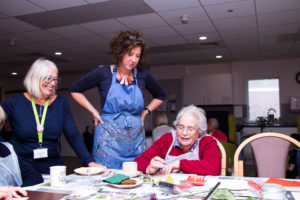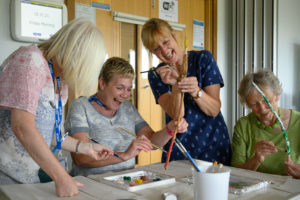Project Art Works
Arts & Culture Impact Fund Project Art Works is an Arts…
Cultural Impact Development Fund
Paintings in Hospitals, an arts and health charity, will use its investment to increase staff capacity to execute its fundraising strategy and to develop commissioning partnerships with CCGs, local authorities, and health and social care membership organisations.
| Region: | South East |
| Discipline | Visual Arts |
| Investment Size | £75,000 (£52,500 loan, £22,500 grant) |
The Organisation:
Paintings in Hospitals is an arts and health charity, operating nationally across health and care settings, using art and creative activities to improve health, wellbeing, and quality of life for people with illness, injury, addiction, autism, and disability. As the first and only national collection of art to support people’s physical and mental health, Paintings in Hospitals’ mission is to reduce levels of sickness, anxiety, and stress in patients, service users, care staff, and the public.
Over the last 60 years, Paintings in Hospitals has evolved its programming from a focus solely on the art collection to a balance of ‘collection’ and ‘connection’, deepening the relationship between access to art and social benefit and engagement with that art.
Paintings in Hospitals’ main programme strand includes the art loans programme and its complementary arts activities. As the organisation’s longest-running programme, the art loans provide health and social care organisations the opportunity to rent items from Paintings in Hospitals’ art collection for the purposes of bringing art into waiting areas, consultation rooms, classrooms, and community spaces. To enable patients, service users, and carers to benefit further from the art loan programme, Paintings in Hospitals involves beneficiaries to choose the artwork and offers bespoke creative workshops and activities such as developing basic artistic skills; activity packs for beneficiaries to facilitate conversation, set creative challenges, and develop their own artwork; and art walks for patients and carers to get active and learn about the art in their care setting.
Today, Paintings in Hospitals cares for 3,600 artworks, including drawings, paintings, prints, sculptures, photographs, textiles and digital works, by artists such as Bridget Riley, Antony Gormley, Maggi Hambling, Yinka Shonibare, Helen Chadwick, Anish Kapoor, Elizabeth Blackadder, Anni Albers, Gillian Ayres, Ben Rivers, Catherine Yass, Alexander Calder, and Elisabeth Frink.

The Opportunity:
Beginning in 2018, Paintings in Hospitals, like many organisations, experienced a gradual decline in reliability of its main income sources. Coupled with the negative social and financial impacts of the pandemic in 2020, Paintings in Hospitals recognised a reset of the organisation’s strategy was needed to remain financially viable and responsive to the needs of its beneficiaries.
Paintings in Hospitals approached the Culture Impact Development Fund (‘CIDF’) with a request for a £150,000 investment to develop a robust commissioning and art loan pipeline with CCGs, local authorities, and health and social care membership organisations, and to diversify fundraising income to replace less secure grant income. This investment was financed through a blended package of grant and loan with an initial investment of £75,000 made in 2021 and an additional sum of £75,000 available to be released in 2022 if needed.
In addition to financial resilience, the CIDF grant & loan will support efforts to increase social impact. Investment in the organisation’s commissioning capacity will improve Paintings in Hospitals’ opportunities to work with carers and elderly patients in care homes (and other care settings for vulnerable people).

The Process:
When Paintings in Hospitals first approached CIDF in late 2020, the organisation had recently undergone a leadership transition and was in the middle of a restructure. The CIDF team worked closely with management to consider different programme delivery methods, staff capacities and financial scenarios that would lead to a more financially resilient and responsive organisation.
Alongside the due diligence process, Paintings in Hospitals received one-to-one support from CIDF to strengthen its approach to monitoring and evaluating its social impact. Through an organisational assessment it was determined that Paintings in Hospitals is well-placed to continue delivering and scaling up this service, however, the process also found that Paintings in Hospitals would benefit from capacity building support to develop future evaluation plans. The overall purpose of the evaluation plans will be to capture the impact of its work on health and care settings partners and their service users, which will allow the organisation to better evidence and communicate the value of its service to the wider public, particularly for fundraising purposes. Paintings in Hospitals also aims to collect feedback from setting staff and service users to ensure that its services are fit for purpose and to inform future delivery strategy.
Through taking this structured approach to monitoring and evaluation, Paintings in Hospitals and CIDF will create a robust data set to provide benchmarks for setting targets for the organisation’s future impact. With CIDF’s pioneering use of financial incentives in return for social impact, these plans and targets will also serve as the basis for determining reductions in interest rates over the lifetime of its investment.
The Impact:
Historically, Paintings in Hospitals’ pathway to impact has been through the lending and display of visual art in health and care settings. In recent years the organisation has more proactively engaged service users and staff through complementary arts workshops, and engaging service users and staff to select the art that will be displayed in their setting.
Through the CIDF investment, Paintings in Hospitals will grow its commissioning capacity and, over the life of the investment, intends to build out this proactive engagement effort through continuing to deliver engagement activities with service users and staff, as well as upskilling health and care workers on how to deliver creative activities within their setting.